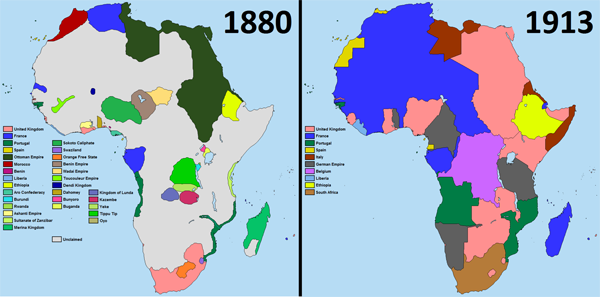The Berlin Conference can be best understood as the formalisation of the Scramble for Africa. This British coined the term sometime in 1884, and it has since been used to describe the twenty-plus years when the various European powers explored, divided, conquered and began to exploit virtually the entire African continent. European powers were slow to realise the benefits of claiming land in Africa and had mainly kept to coastal colonies. However in 1884–5 the Scramble for Africa had truly began in earnest when thirteen European countries and the United States met in Berlin to agree to the rules dividing Africa. The outcome of the conference was the General Act of the Berlin Conference.
Prior to the conference, European diplomacy treated African indigenous people in the same manner as they treated New World natives, forming trade realtions with tribal chiefs. This can seen in examples such as the Portuguese trading with the Kingdom of the Kongo. With the exception of the trading posts along the coasts, the continent was essentially ignored. This changed as a result of King Leopold of Belgium’s desire for personal glory and riches and by the mid-19th century, Africa was considered ripe for exploration, trade, and settlement.
In 1876, Belgium’s King Leopold II announced his intent to fund an exploration of the Congo region, and in 1879 Leopold sent Sir Henry Morton Stanley to the area. In the same year, the French began building a railway east from Dakar, hoping to tap potentially huge Sahelian markets. That year France also joined Great Britain in taking financial control of Egypt.
From 1879 to 1885, Stanley went to the Congo as an envoy from Léopold with the secret mission to organise what would become known as the Congo Free State, a mercantile enterprise in the Congo. French intelligence had discovered Leopold’s plans, and France was quick to engage in its own colonial exploration. French naval officer Pierre de Brazza was dispatched to central Africa, traveled into the western Congo basin, and raised the French flag over the newly founded Brazzaville in 1881, in what is currently the Republic of Congo. To add to this, Portugal, had a long history in the are through its trade and treaties with the Kongo Empire in the area through its treaties with the Kongo Empire which in essence became a proxy state of Portugal. It quickly made a treaty with its old ally, the United Kingdom of Great Britain and Ireland, on 26 February 1884 to block off the Congo Society’s access to the Atlantic.
By the early 1880s European interest in Africa had increased dramatically. Stanley’s charting of the Congo River Basin (1874–77) removed the last bit of terra incognita from European maps of the continent, thereby delineating the rough areas of British, Portuguese, French, and Belgian control. The powers raced to push these rough boundaries to their furthest limits and eliminating any local minor rulers which might prove troublesome to European competitive diplomacy.
France moved to occupy Tunisia, one of the last of the Barbary Pirate states, under the pretext of another Islamic terror and piracy incident. French claims by Pierre de Brazza were quickly solidified with the French taking control of today’s Republic of the Congo in 1881 and also Guinea in 1884. This, in turn, partly convinced Italy to become part of the Triple Alliance, thereby upsetting Germany's Otto van Bismarck’s carefully laid out plans with Italy and forcing Germany to become involved. In 1882, realizing the geopolitical extent of Portuguese control on the coasts, but seeing penetration by France eastward across Central Africa toward Ethiopia, the Nile, and the Suez Canal, Britain saw its vital trade route through Egypt and its Indian Empire threatened.
 Comparison of Africa in the years 1880 and 1913. Image source
Comparison of Africa in the years 1880 and 1913. Image source
Under the pretext of the collapsed Egyptian financial structure and a subsequent riot in Cairo which saw hundreds of Europeans and British subjects murdered or injured, the United Kingdom intervened in nominally Ottoman Egypt, which, in turn, ruled over the Sudan and what would later become British Somaliland.
Owing to the upsetting of Bismarck’s carefully laid balance of power in European politics caused by Leopold’s gamble and subsequent European race for colonies, Germany felt compelled to act and started launching African expeditions of its own, which frightened both British and French statesmen. Hoping to quickly soothe this brewing conflict, King Leopold II was able to convince France and Germany that common trade in Africa was in the best interests of all three countries. Under support from the British and the initiative of Portugal, Otto von Bismarck, German Chancellor, called on representatives of Austria-Hungary, Belgium, Denmark, France, the United Kingdom, Italy, the Netherlands, Portugal, Russia, Spain, Sweden-Norway (union until 1905), the Ottoman Empire, and the United States to take part in an international conference in Berlin to work out a common policy for colonisation and trade in Africa and the drawing of colonial state boundaries in the official partition of Africa. The United States, however, did not actually participate in the conference both because it had an inability to take part in territorial expeditions as well as a sense of not giving the conference further legitimacy. The Berlin Conference spanned almost four months of deliberations, from 15 November 1884 to 26 February 1885. By the end of the Conference the European powers had neatly divided Africa up amongst themselves, drawing the boundaries of Africa much as we know them today.